|
|
General: PIRAMIDES EN CHINA (ALINEACION CON ISLA DE PASCUA)/SOLSTICIOS Y EQUINOCCIOS
Elegir otro panel de mensajes |
|
|
La Numerología no nos da buenas noticias de esta fecha arriba mencionada ya que los números 29 y 11 "No son auspiciosos". El número 29 es considerado como: "El Karma más pesado de todos los números" y el número 11, el siempre misterioso el cual ha jugado constantemente un rol protagónico en "Acontecimientos muy negativos".
(11+8+2008)=(11+8+10) y esto suma 29 y 29=(2+9)=11.
Del laberinto se dice:
- El edificio más grande construido por el hombre.
- Esta construcción tardó 365 años (Desde el 4.608 hasta el 4.243) A.C.
- Contiene el "Círculo de Oro", la cual es una legendaria habitación a la que se hace referencia el "Libro de los muertos". Esta hecha de granito y recubierta en oro, lleno con un legado tecnológico que nos dejó una civilización perdida, mucho más antigua que el mismo Egipto.
- El conocimiento astronómico de los Egipcios está escrito en grandes paredes, todos sus hallazgos astronómicos pueden leerse en los jeroglíficos y todas las constelaciones estelares figuran aquí en un enorme zodíaco.
- Muchas paredes pueden moverse y esto lo convierte en un laberinto real. Los textos antiguos hablan sobre personas que perdieron su camino y murieron, también se habla de habitaciones secretas que se encuentran en este laberinto; llenas de utensillos y documentos de una civilización que floreció a una escala mundial hace miles de años.
- Contiene habitaciones con documentos sobre la historia de Egipto y su conocimiento astronómico.
- Alineadas con los puntos cardinales, y con los equinocios…
Y extrañamente alineados en una misma recta con una inclinación de 30 grados con respecto al ACTUAL ecuador!

Las pirámides de China no las conocen muchos…el gobierno chino se ha encargado de encubrirlas…ya que las leyendas dicen que sus constructores fueron gigantes rubios de ojos azules…
Pero en China tenemos más de 100 pirámides…y entre ellas destacan las "Giza" de China…
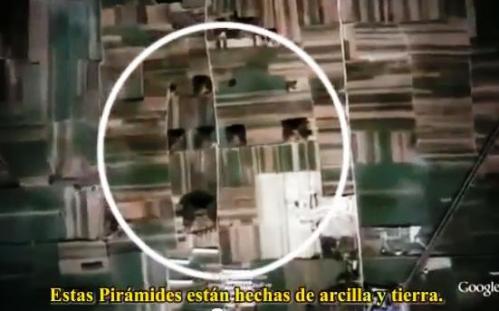
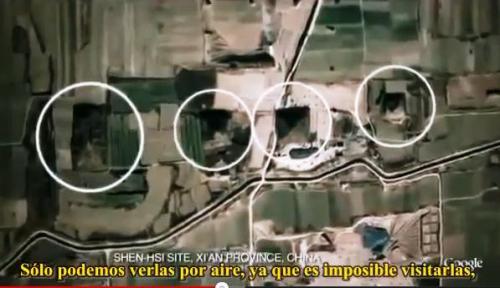
Recordar que Giza tiene 675 feet de base!
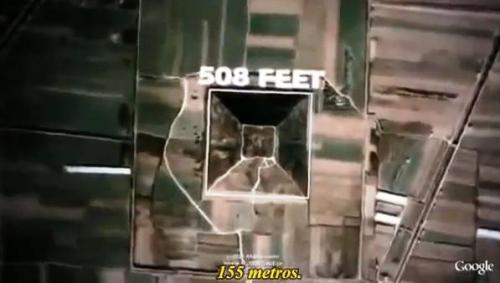
|
|
|
|
|
Y extrañamente alineados en una misma recta con una inclinación de 30 grados con respecto al ACTUAL ecuador!

Las pirámides de China no las conocen muchos…el gobierno chino se ha encargado de encubrirlas…ya que las leyendas dicen que sus constructores fueron gigantes rubios de ojos azules…
Pero en China tenemos más de 100 pirámides…y entre ellas destacan las “Giza” de China…


Recordar que Giza tiene 675 feet de base!

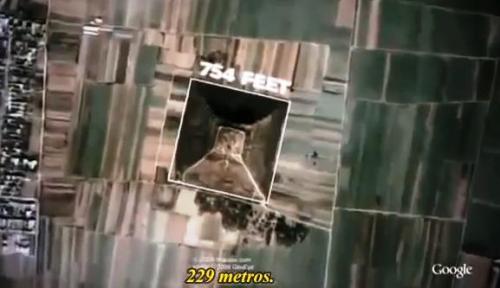
Y la más grande es de 339 metros de base!!!

Terrible que los chinos las quieran camuflar plantando árboles…

|
|
|
|
|
Articles by Gary A. David
Along the 33rd Parallel: A Global Mystery Circle
by Gary A. David

What’s In a Number?
The number 33 enigmatically stretches as a latitude line across many diverse cultures in many different times. Known in numerology as the Master Teacher, 33 is the most influential of all numbers, indicating selfless devotion to the spiritual progress of humankind. The other two master numbers, 11 (vision) and 22 (vision with action) form the base of a two-dimensional pyramid, and added together equal 33 (guidance to the world), the apex of the pyramid. [1] On the reverse of the Masonically inspired Great Seal of the United States is the pyramid with the all-seeing eye of divine Reason at its apex. According to ritual Freemasonry, XXXIII is considered sacred because in most cases there is no higher degree or level to which a Mason may aspire.
In a Biblical context we note that King David ruled in Jerusalem for thirty-three years, Jacob had thirty-three sons and daughters, and Jesus Christ was crucified at age thirty-three. Two interpenetrating triangles whose apexes point in opposite directions form the hexagram of the Star of David (3 + 3 = 6). On the other hand, 3 X 3 = 9, or the Ennead, the nine primal gods of Egyptian mythology.
The late thirteenth/early fourteenth century Italian poet Dante ended Canto XXXIII of the Purgatorio, or the second section of his Divine Comedy: “...perfect, pure, and ready for the Stars.” [2] Canto XXXIII of the Paradiso, or the third section, concludes with lines about the poet being turned “as in a wheel whose motion nothing jars-- / by the Love that moves the Sun and the other stars.” [3] It is more than a coincidence that the 33rd canto of each section concludes with parallel lines regarding the celestial; it may instead be the code from a lost ancient tradition.
This number even permeates the biological realm studied by science: thirty-three is the number of turns in a complete sequence of DNA. [4] A more ominous connotation appears in the 33rd element of the periodic table. Arsenic is a brittle, steel-gray substance that is actively poisonous. The Greek root arsen means “male, strong” or “virile,” which suggests the active reach of this potent and potentially deadly number across the globe. Indeed, when we consider the northern latitude of 33 degrees, some intriguing synchronicities, or “meaningful coincidences,” are found. [5]
You Say Phoenix and I Say Phoenicia
The first stop on our tour along the 33rd parallel is the metropolis of Phoenix, Arizona, located at 33 degrees 30 minutes latitude. Gleaming like a steel and glass mirage surrounded by ironwood, palo verde, and saguaro cactus, this modern American city lies in a brown cloud of auto exhaust at the northern end of the Sonoran Desert. Its imported palm trees and omnipresent swimming pools shimmer when seen from high in the air like turquoise and silver jewelry on a jet-setter’s tanned breast. In essence, Phoenix is pervaded with the aura of the foreign and the bizarre. Few casual tourists realize, however, that this was once the center of the ancient Hohokam culture.
The largest Hohokam site known as Snaketown was located about five miles north of the exact 33 degrees line, while the ruins of the astronomical observatory called Casa Grande still rest about five miles south of the line. The Hohokam inhabited the Valley of the Sun perhaps as early as 300 B.C. (about the time of Alexander the Great and the Ptolemaic Dynasties in Egypt) and built one of the world’s most extensive irrigation systems. These ancient American Indians created an estimated total of 500 miles of canals to irrigate over 25,000 acres in the Phoenix Basin-- all constructed with mere digging sticks, stone implements, and woven carrying baskets. In fact, no wheelbarrows or draft animals were ever used. The main canals leading from the Salt and Gila rivers measured up to 75 feet across at the top and 50 feet wide at the bottom. [6] As Southwestern archaeologist H. M. Wormington observes, “The scope of the canal project suggests comparisons with the erection of the huge pyramids of Egypt or the great temples of the Maya.” [7] Clearly this monumental technology was the key factor that allowed the desert dwelling people to inhabit their extremely harsh region for well over a thousand years.
Skipping across the Atlantic on the same parallel, we find a number of intriguing sites in the Old World. For instance, at a latitude of 33 degrees 19 minutes was located the primary Phoenician seaport of Tyre (now called Sûr), almost 50 miles south of Beirut. Dating back as early as 5000 B.C., Tyre was renowned for a purple-red dye obtained from the snails of the genus Murex. [8] The color is one of the meanings of the word “phoenix,” which the ancient Egyptians sometimes associated with the purple heron.
Back in North America the “place of the heron” refers to Aztlan, the Nahuatl word for the mythical land that the Aztecs inhabited after emerging from Chicomostoc, the Seven Caves located in the bowels of the earth. [9] Chicano folklore identifies Aztlan as that portion of Mexico taken over by the U.S. after the Mexican-American War of 1846-- in part, the Arizona Territory, where the settlement of Phoenix arose.
The Masonic author Albert Pike states that Tyre was the seat of the Osirian Mysteries after they had been imported from Egypt. [10] Pike asserts that the two massive columns situated at the entrance of the Tyrian Temple of Malkarth were consecrated to the Winds and to Fire. This pair is thought to be the prototype of Jachin and Boaz, the two pillars found on the eastern wall of every Masonic temple in the world. On the right, or to the south, is Jachin, which means “He shall establish” and signifies an active, vivifying force. On the left, or to the north, is Boaz, which means “In it is strength” and connotes passive stability and permanence. [11] Freemasons Christopher Knight and Robert Lomas suggest that the former represents the winter solstice sunrise, while the latter the summer solstice sunrise. [12] Although this is possible, we propose that Jachin represents the southern stargate between Sagittarius and Scorpius while Boaz signifies the northern stargate between Gemini and Taurus. [13] Our assumption is based on the fact that in the York Rite of Freemasonry a celestial globe symbolizing ex-carnation (i.e., a spirit leaving its present body) is found atop Jachin while a terrestrial globe representing incarnation is positioned atop Boaz. [14]
During the tenth century B.C. King Hiram of Tyre supplied King Solomon with craftsmen, metallurgists, cedar wood, architectural design, and presumably the esoteric symbolism of these two columns for the construction of his temple at Jerusalem. (1 Kings 7: 13-22) [15] In addition to being besieged at various times by Nebuchadrezzar, Alexander the Great, the Romans and others, the trade capital city-state of Tyre was conquered in the twelfth century A.D. by the Crusaders, who built a Knights Templar church there.
Some speculate that the orientation of the two pillars imitates obelisks placed before the pylons of Egyptian temples, especially those of the Heliopolitan temple of Thothmes (Tuthmosis) III, who reigned in the fifteenth century B.C. as the militarily expansionist pharaoh of the Eighteenth Dynasty. He is also thought to be founder of the Order of the Rosy Cross, or the Rosicrucians. [16] The archaeologist Sir Flinders Petrie even found records in the Libyan desert that describe a secret Masonic guild meeting held circa 2000 B.C. “The guild met to discuss working hours, wages, and rules for daily labor. It convened in a chapel and provided relief to widows, orphans, and workers in distress. The organizational duties described in the papyri are very similar to those of ‘Warden’ and ‘Master’ in a modern branch of the Brotherhood which evolved from those guilds: Freemasonry.” [17] It seems that all roads lead to... Egypt.
Also of interest near the 33rd parallel is Byblos, a bit farther north of Tyre at a latitude of 34 degrees 08 minutes. The name of this city state is derived from the Greek ta b blia, which means “the book,” or “bible.” Indeed, the invention of a Phoenician alphabetic phonetic script occurred here and eventually spread to the Greek world. [18] A bit farther east at nearly the same latitude is Baalbeck, an ancient megalithic temple constructed with some of the largest stone blocks ever cut in the world. Extracted and hauled from a quarry many miles away, these megaliths include one block measuring 80 feet long and weighing 1,100 tons. [19] In this section we have seen how Phoenix and Phoenicia are linked by latitude. We shall continue eastward to encounter other significant ancient sites along the same parallel.
A Passage To China
A little over 500 miles east of these Phoenician cities at 33 degrees 20 minutes is modern-day Bagdad in Iraq, with Babylon located about 55 miles to the south. This ancient capital of Mesopotamia on the banks of the Euphrates River was once the largest city in the world, encompassing over 2,500 acres. The construction of Babylon began during the twenty-third century B.C. and included the Temple of Marduk (known as Esagila) as well as the legendary Tower of Babel (identified as Etemenanki). The latter structure was a seven-tiered ziggurat rising to a height of 300 feet with a base on each side measuring the same distance. This measurement, incidentally, equals the length of the Hohokam platform mound at Pueblo Grande in Phoenix, Arizona. On the eastern side of Babylon was an outer rampart of triple wall construction extending for 11 miles. A network of irrigation canals reminiscent of the Hohokam also once served the city. In addition, the terraced Hanging Gardens were one of the Seven Wonders of the Ancient World. [20]
This “city and a tower” (Genesis 11:4) was known as Ba-bel, the legendary site of the linguistic confounding. “The biblical interpretation of the name is fanciful. The Bible connects Babel with the Hebrew verb Blal, ‘to confuse’, whereas it really comes from Bb-ili, which in Babylonian means ‘Gate of God’.” [21] This terrestrial correlation to another sort of stargate is perhaps a reference to the Processional Way leading to Ishtar Gate, both of which were adorned with glazed blue enameled figures of lions, bulls, and dragons. Pike maintains that the temple contained a representation in silver of two large serpents. “The Greeks called Bel Beliar; and Hesychius interprets that word to mean dragon or great serpent. We learn from the book of Bel and the Dragon, that in Babylon was kept a great, live serpent, which the people worshipped.” [22] This reminds us of the Place of the Snakes, or the Hohokam site of Snaketown, as well as of the Hopi biennial Snake Dance ceremony still performed with live rattlesnakes on the high desert of Arizona.
In more recent times Babylon played a significant role in the rituals of Freemasonry and continues to do so. For instance, Knight and Lomas discovered that the ceremony for the Royal Arch of Solomon Degree (13 degrees) entails the candidate and two others playing the roles of the three Master Masons of Babylon: Shadrach, Meshech, and Abednego. According to the narrative told in the ritual, these children of the Babylonian captivity desire to assist in the rebuilding of the Temple of Solomon. Thus, Babylon’s symbolic importance, which the co-authors believe extends back to at least Knights Templar times and probably before, is reemphasized inside every Masonic lodge to the present day. [23]
Traveling along the 33rd parallel from the Middle East to the Far East, we encounter the fabulous White Pyramid located about 60 miles southwest of X’ian (Sian or Hsian) in the Qin Ling Shan Mountains of China’s Shensi Province. This city was made famous for the nearby discovery of the Terra Cota Warriors. Resting at almost the same latitude as Phoenix’s 33½ degrees, this massive stepped pyramid constructed of clay is estimated to be 1,000 feet high and 1500 feet at the base! The current politics of the country have thus far prevented any detailed study of the structure, but it is thought to be 4,500-5,000 year old-- the approximate age of the pyramids at Giza. The White Pyramid was built supposedly after the old emperors, known as “the sons of heaven,” descended to Earth in their “fiery metallic dragons” and began to rule China. Its interior is rumored to be a model of this empire with a jeweled roof depicting the constellations and rivers of flowing mercury. The region also contains up to one hundred more pyramids. [24]
Highway 33 Revisited
Back on the North American continent, if we journey somewhat over 1,500 miles east of Phoenix along latitude 33 North, we find the Moundville site lying exactly on the line. This city constructed by the Mississippian culture along the Black Warrior River in central Alabama from 1000 through 1450 A.D. had a population of over one thousand-- second in size and complexity to ancient Cahokia in Illinois. The 26 earthen platform mounds arranged in a circular pattern are similar in structure to those in Arizona’s Valley of the Sun, with temples and residences for the elite priesthood likewise built on top. One of the larger mounds is a ramped pyramid that rises to a height of 58 feet. In addition, the town was protected on three sides by wooden palisades, much like the Hohokam villages along the Salt and Gila Rivers. [25] Did the earlier Hohokam culture of the American Southwest somehow influence the later development of this Mound Builder culture in the American Southeast? The many similarities between the two seem to point in that direction.
A few other Mound Builders cities were settled quite near the 33rd parallel. Approximately 10 miles southwest of the town of Lake Providence (32 degrees 49 minutes) on the Mississippi River floodplain in northeastern Louisiana is Poverty Point State Historic Site. Constructed in 1800 B.C. (much earlier than even the Hohokam settlements), a C-shaped or perhaps a partial octagon-shaped earthwork three-quarters of a mile across was formed by six concentric ridges that are 140 to 200 feet apart and four to six feet high. To the west of this earthwork, Bird Mound rises 72 feet high and extends 600 to 800 feet at its base. Resembling some sort of fowl flying toward the sunset, this mound was constructed using 300,000 cubic yards of clay, or the equivalent to 10 million 50-pound baskets. To truly realize the shape of the bird, one needs to be at least a thousand feet or so in the air. Poverty Point was almost entirely abandoned circa 1350 B.C., indicating over five centuries of cultural development, though minor construction on the earthworks continued until 700 A.D. [26]
Even closer to the magic number 33 though not as impressive or as old are the Winterville Mounds, located six miles north of the town of Greenville in west-central Mississippi (33 degrees 25 minutes). Inhabited between 1000 and 1450 A.D., the site includes 23 flat-topped mounds, with the main Temple Mound rising 55 feet. [27]
About four miles south of Cartersville in northwestern Georgia (34 degrees 11 minutes) is Etowah Indian Mound State Park. “White settlers understood the Creek and the later Cherokee to call this site “Hightower,” possibly for Itawa or Italwa (city?). The name Etowah may also be a corruption of this word.” [28] It is interesting to note that the Hopi word for the sun deity is Tawa. Etowah was first inhabited in 950 A.D. and contains three major mounds. One is a ceremonial mound 63 feet in height and another is a burial mound in which were found numerous artifacts including copper ear ornaments, stone effigies, and sea shells along with obsidian and grizzly bear teeth from the Rocky Mountains. [29]
Closer to the home of the Hohokam on the western side of the Colorado River are located a number of geoglyphs (also called “intaglios”). These figures formed in the desert by removal of darker pebbles to reveal a lighter undersurface are sometimes hundreds of feet in length. One group (the Blythe complex) is positioned about 16 miles north of Blythe, California (33 degrees 40 minutes), while another group (the Ripley complex) is located about 12 miles south of Blythe. In addition to human and animal figures, snakes, spirals, stars, circles, and other geometric figures, a Knights Templar-like Maltese cross nearly 10 feet in diameter has been found adjacent to a humanoid figure at the Ripley complex. [30] One anthropoid geoglyph in the area has been associated with the Hopi Fire Clan deity Masau’u. [31] Hence, we find that many different tribes were apparently involved in these rituals dating from between 1,100 and 3,000 years ago. [32] Because these earth forms, like the Nazca lines in Peru or Bird Mound at Poverty Point, are best appreciated from the air, they were probably intended to be an homage to the sky gods.
The geoglyphs together with other cairns, stone circles, and cleared dance paths may be ritually associated with the huge network of interconnected trails found in the low desert upon which the ancients made pilgrimages. One such pilgrimage called the keruk is performed even today by the Yuman speaking tribes (viz., the Yuma, Mohave, Cocopa, and Maricopa) in a four-day trek to Avikwa’ame, the sacred mountain to the north, in order to celebrate the cosmogony. [33] “The route ran from Pilot Knob, or Avikwal [near Yuma, Arizona], the spirit house where the dead dwell at the southern end of the river, to Avikwa’ame, or Spirit Mountain, where the Earth was created, in the north. This pilgrimage was intended to honor the creation, and ritually retrace the path of Mastamho [the creator-deity, whose name echoes the Hopi god Masau’u mentioned above] in his mythic adventures.” [34] Here we find a north-south dichotomy similar to that found along the Nile, with the “Mound of Creation” (i.e., Heliopolis) located to the north. Atop Avikwa’ame, legends say, was a great house name Aha-avulypo, or literally “Dark Round House.” [35] The north-south road itself was named Kwatcan, the “first trail to the homeland.” The Hopi word for “track” is kuku’at, but the word for “grandfather” is the near homophone kwa’at. [36] Perhaps the suffix -can is a variant of “ka,” part of the word kachina. [37] Either “spirits of the track” or “spirits of the grandfathers” may be the intended meaning. Midway on this spirit road between the sacred mountain of the North and the mouth of the Colorado River are the aforementioned geoglyphs at the 33rd degree of latitude.
Also on this line is the Three Rivers Petroglyphs site, located on the western base of the Sacramento Mountains 18 miles west of Ruidoso, New Mexico (33 degrees 19 minutes). One of the largest rock art sites in the Southwest, this park contains over 20,000 glyphs scattered over 50 acres. Carved atop a ridge by the Mogollon culture between 900 and 1400 A.D. (contemporary with the late Hohokam period) [38], these figures include anthropomorphs, zoomorphs, kachina masks, star symbols, and various abstract or geometric designs, including a Maltese cross within a circle surrounded by a ring of seventeen dots. [39] “Distinctive at Three Rivers is the circle-dot motif; one investigator who took the trouble to count found it to be the single most common element at this site. Interestedly enough, its presence elsewhere is negligible, and its symbolic content has not been determined, although it occurs in various contexts in Mesoamerica. Possibly it refers to Quetzalcoatl.” [40] This deity, of course, is known as the Plumed Serpent. Three Rivers Site is also unique because it is one of only a few places in the Southwest that were used primarily for rock art rather than it being merely an adjunct to the village. [41] However, another site lying exactly on the 33rd parallel was also used expressly for this purpose. Near Gila Bend, Arizona about 62 miles west of Snaketown (mentioned above) is Painted Rocks [sic] State Park, which has thousands of petroglyphs of similar designs-- not “painted” but pecked into the boulders. [42]
A fascinating site also in the general vicinity of Phoenix is called the Circlestone Observatory (33 degrees 28 minutes). High in the Superstition Mountains about 54 miles east of the metropolis lies an elliptical “medicine wheel” constructed of a stone wall three feet thick with a circumference of 427 feet. On his extensive and thoroughly detailed web site, New Zealand researcher Martin Doutré claims that this structure incorporates various navigational codes, including phi, or the Golden Ratio (1.618...). “Ancient astronomers mathematicians built sites like Circlestone as repositories of codes and places where initiates could be taught age-old principles.” Doutré further suggests that Circlestone was used by colonists from the eastern Mediterranean or Europe who may have operated a gold mine-- perhaps the famous Lost Dutchman’s Mine itself! [43] Although American Indians may instead have constructed this site for an astronomical observatory similar to the one at Casa Malpais near Springerville, Arizona (34 degrees 10 minutes), Doutré’s theory is nonetheless an intriguing one.
Four other ancient sites along latitude 33 N warrant brief mentions. Gila Cliff Dwellings National Monument (33 degrees 22 minutes) is located in a rugged and isolated region about 60 miles west of Truth or Consequences, New Mexico. Reminiscent of the seven Aztecan caves mentioned above, five caves in the Mogollon Mountains of southwestern New Mexico contain about 40 masonry and adobe rooms built circa 1280 A.D., although semi-subterranean pit houses have been found nearby dating back to circa 100 A.D. [44]
In saguaro cactus country about 56 miles northeast of Phoenix is another site on the global mystery circle called Tonto National Monument (33 degrees 44 minutes), which also contains cliff dwellings within shallow caves. Constructed of unshaped quartzite and adobe mortar, these ruins inhabited in the mid-fourteenth century contained 70 rooms within three caves. [45]
About 40 miles due east of the small town of San Carlos, Arizona (33 degrees 24 minutes) is Point of Pines Ruin. Occupied between 1200 and 1500 A.D., this huge masonry pueblo contained 800 rooms, a central plaza, a surrounding wall, and a great kiva. [46] The site is also one of the few in the Southwest that shows evidence of three different cultures living together: the Hohokam, the Mogollon, and the Anasazi-- the last group named migrating from the Hopi country to the north. [47] The population is estimated to have been between 2,000 and 3,000. [48] Incidentally, five or so miles to the south is a hot springs called Arsenic Tubs, number 33 on the periodic table.
And finally, Besh-ba-gowah Archaeological Park located one-and-a-half miles south of downtown Globe, Arizona (33 degrees 25 minutes) was a granite cobble pueblo of 250-plus rooms inhabited between 1225 and 1450 A.D. The artifacts found include copper bells and macaw feathers from Mesoamerica as well as shells from the Gulf of Mexico and the California coast. [49] Besh-ba-gowah is an Apache phrase meaning “place of the metal,” referring to the copious silver and copper deposits in the area. In fact, the town of Globe was so named because of the 1875 discovery of a globe-shaped mass nine inches in diameter made of 99% pure silver and valued at $12,000. Curiously, reports also stated that the continents of the Earth were etched upon its surface. The whereabouts of this artifact are currently unknown. [50]
A Brief History of 33
Entering the historical period, we find hovering near the 33rd parallel a number of provocative synchronicities. For instance, the first Supreme Council of the Ancient and Accepted Scottish Rite of Freemasonry, Southern Jurisdiction of the United States, was established in 1801 at Charleston, South Carolina. This charming antebellum port city and hub of southern culture is located less than 15 miles south of the 33rd parallel. Called the Solomon Lodge No. 1, the Masonic meeting place was known as the Mother Lodge of the world. [51]
Shortly before the end of World War II Franklin D. Roosevelt died suddenly of a cerebral hemorrhage at Warm Springs, Georgia, which is less than 10 miles south of 33 degrees latitude. (This town, incidentally, is located about 35 miles northeast of Phenix City, Alabama.) It is noteworthy (no pun intended) that in the mid-30s FDR, a 32nd degree Mason and 32nd President of the U.S., initiated the printing of the reverse side of the Great Seal (the pyramidal eye mentioned at the beginning of this essay) on the legal tender. Roosevelt was succeeded in April of 1945 by 33rd degree Mason Harry S. Truman. (The “S.” supposedly stood for Solomon.) On July 16th of the same year, the first atomic device --the Gadget, as it was called-- was detonated at Trinity Site, New Mexico: 33 degrees 41 minutes North latitude. Spanish explorers originally called this area La Jornada del Muerto, or “The Journey of the Dead,” but now the site is marked by a small stone obelisk erected twenty years or so after the explosion. [52] (Was this monument Masonically inspired?) [53] A few weeks after the explosion at Trinity Site the 33rd president of the United States ordered the annihilation of two Japanese cities by nuclear bombs dropped from B-29 bombers. The 33rd parallel runs exactly between Hiroshima and Nagasaki. Two years after the war ended, the modern “flying saucer” age began in earnest when something crashed near Roswell, New Mexico-- 33 degrees 26 minutes North latitude.
Bringing us up to the present day, the so-called Phoenix Lights were witnessed by hundreds or perhaps thousands of people. On the evening of March 13th, 1997 an immense triangular UFO perhaps a mile wide flew over the American Southwest. First sighted over Henderson, Nevada at 6:55 p.m. (Pacific Standard Time) traveling southeast, this virtually silent craft (for lack of a better term) had a number of lights evenly spaced on its leading edge. It was next seen 22 minutes later over the village of Paulden, Arizona (nearly 25 miles north of the town of Prescott). It was then observed 10 miles to the south in Chino Valley, where it apparently streaked over the present author’s house, who missed seeing the event by a matter of minutes. Just one minute after the Paulden sighting, it was reported over Prescott Valley, which is 23 miles south-southeast of the former.
By 8:23 (Mountain Standard Time) the object had reached the Phoenix metro area roughly 75 miles away, where it hovered for about four or five minutes over the vicinity of the Indian School Rd. and 7th Avenue intersection. Next the UFO entered Sky Harbor Airport’s air space, where air controllers in the tower and the flight crew from at least one commercial airliner viewed it, although radar failed to detect it. The craft continued southeast above Interstate 10 and was sighted in the Tucson area about 8:45. [54] This series of sightings that occurred within a 400-mile stretch took just 50 minutes. The average speed of the craft was 480 m.p.h.
At approximately 9:50 p.m. an arc of amber “orbs” measuring one mile across appeared above the Estrella Mountains about 20 miles southwest of Phoenix. “Spanish explorers named the range Estrella (‘star’) after the pattern of deeply carved canyons radiating from the summit.” [55] This display of lights videotaped by scores of people in the Phoenix area was possibly related to the earlier sightings. At the time of this latter UFO sighting the constellation Orion would have been seen hovering over the southwestern horizon, were it not for urban light pollution. In fact, at 9:49 p.m. when the final phase of the event was beginning, Alnilam, the middle star of the Belt, was 33 degrees above the horizon at an azimuth of 242 degrees. If a line is drawn from the State Capitol to the Estrella range’s Monument Hill (the initial point for surveying of property in Arizona), the azimuth is also 242 degrees. At the latitude of Phoenix this is the exact point of the winter solstice sunset as well. Thus, these orbs appeared at a significant archaeo-astronomical position in the sky and also in the precise region where Orion happened to be at that particular time. Above the right hand of Orion between the constellations Gemini and Auriga is the northern stargate previously mentioned, located at a declination (celestial latitude) of 33 degrees.
One odd aspect to the Phoenix Lights story is that, other than a few minor write-ups in local newspapers, they were not reported in any national media until June 18th, over three months later, when USA Today ran a front-page article picked up by the other media. [56] In any event, one of the most intriguing UFO sightings in decades was focused upon the 33rd parallel-- a paramount Masonic number.
Why are so many significant ancient and historic sites located along the 33rd parallel? Perhaps the ancients discovered a ley line sort of dragon energy corresponding to this latitude, and constructed temples and sacred cities in order to utilize this terrestrial chi. Or perhaps the numerological and Masonic significance of 33 dictated that monuments to this sacred number be erected as a signal to future generations. Whatever the rationale, the 33rd parallel is a path of power across the globe, a circuit that links both time and space in order to vitalize the dynamo of a mystery we are just now beginning to realize.
|
|
|
|
|
|
randísimo Gurú burbujista
|
|
Fecha de Ingreso: 07-abril-2008
Ubicación: Cerca de mi casa
Mensajes: 3.544
Gracias: 6.973
3.248 Agradecimientos de 1.502 mensajes
Ignorar usuario para siempre
|
|
Los Uyughures de China Central (junto al Tibet)...... sobrevientes de Mu? Pelirrojos caucásicos o mongoloides?  
 |
Click para ampliar |
 Centroasiaticos pelirrojos y de ojos claros? !! WTF !!   María Magdalena  Todo parece indicar algún tipo de "problema planetario" hace 12.000 años +- del que apenas vislumbramos restos dispersos de todo tipo. Nos faltan muchas piezas del puzzle pero las que tenemos encajan con sorprendente elegancia. PIRAMIDES DE XIAN
 |
Click para ampliar |
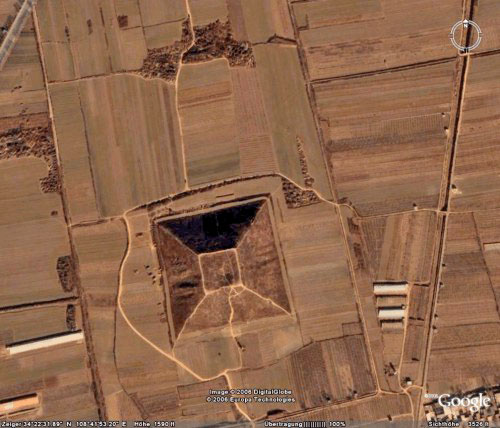
 |
Click para ampliar |
 Harwitum in English: Episode XXIV: Xi'An - ChinaEnigmas of the Ancient Megalithic Structures Harwitum in English: Episode XXIV: Xi'An - ChinaEnigmas of the Ancient Megalithic StructuresUna parte del texto evidencia claramento lo que IM mostró sobre Orión y Gizeh alineamiento que sólo es perfecto (sin desviaciones), si el polo norte y sur (hace unos 12.000 años) tuvieran su posición invertida con respecto al momento presente  "The "Orion Correlation Theory" from author, lecturer and Ancient Egypt researcher Robert Bauval (robertbauval.co.uk), is based on his assumption that the three large pyramids at the Giza plateau of Egypt, are conclusively matching the three stars from the Orion's Belt (Zeta Orionis, Epsilon and Delta) from the star constellation of Orion. Furthermore, two of the other stars of Orion also seem to match with the low destroyed pyramid (or temple) in Abu Rawash and the pyramid in Zawjet Al Arjan. The Milky Way was seen as a candidate to match the Nile river, but the curious thing is that the pattern of the Milky Way and Orion only matches the pattern of the pyramids and the Nile in and around the times of 10,500 BCE, as the Milky Way had been migrated 8 miles to the east during that timespan. Could this suggest that these pyramids possibly were at least some 12,500 years old? However, as one could see, these pyramids at Giza are not perfect mirror images of these stars, as they actually are an *opposite* reflection of the Orion's Belt, and the Milky Way is on the wrong side. The alignment would only be correct as the earth would have been flipped vertically. Could it be that this aligment was correct in the ancient past, before a possible vertical flip of the earth resulting from a full reversal of its north and south poles? And could this have any revelance to the way the ancient Egyptian drew their maps with the south at the top? Because, in these maps, Upper Khemit (Upper Egypt) was shown south, while Lower Khemit was shown north. Constellation of Orion The writings which are today known as: the "Egyptian Book of the Dead", are generally considered as only describing the happenings after death and the afterlife. It could possibly be however, that certain lines from chapter 17 were possibly some kind of historic record: "The dismay after the incredible horror of the catastrophic disaster is making it impossible for the terrorized population to escape! That is what heavenly words tell after the two brothers killed each other!" "Life began again after that, under the course of the new sun, and the young ones found their souls again." "The presence of the importance of the orders they became twins of Osiris. That is why, after the destruction wanted by the celestial combinations to get permission to the place, the old Lion turned around," "following the order of the world to turn around!" The sentence: "the old Lion turned around" could refer to a reversal of the north and south poles of the earth, caused by a shift of the earth's magnetic poles; a "pole shift". If this happened in an instant, this must have caused a great catastrophy and it would have appeared as if the star constellations in the night sky, including the constellation of Leo, turned upside down and started to move in the opposite direction. As described in the book: "The Way of the Essenes: Christ's ****** Life Remembered (1992)", by Anne and Daniel Meurois-Givaudana, at a certain point in time it was seen as if the stars actually fell down from the heavens, thus suggesting a very sudden reverse of the poles. According to various psychic intuitives including Edgar Cayce, this last shift of the magnetic poles had happened during the end of the last glacial age around 9,900 BCE, which caused earth changes which led to the sinking of the remaining islands of Atlantis." |
|
|
|
Incluso ahora, un equipo financiado por el Gobierno está explorando las misteriosa pirámide que algunos investigadores afirman que es una antigua y gigantesca base extraterrestre. [C-1040:Base alienígena en la gran pirámide de China]
Vista aérea del complejo de la Pirámide Xianyang revelando la plataforma de aterrizaje plana.
|
|
|
|
|
|
|
Pirámide de Xi'An
De Wikipedia, la enciclopedia libre

Reconstrucción de la pirámide de Han Yang Ling.
La Pirámide de Xi'An es la mayor y más antigua de las llamadas "pirámides chinas". Según los arqueólogos, tuvo una altura de entre 50 y 70 m, llegando a medir casi 350 m de lado. Está construida con cerca de 3,5 millones de toneladas de tierra apisonada o tapial, y sirvió de tumba al primer emperador de China Qin Shi Huang, fallecido en el 210 a. C.[1]
La pirámide constituía el foco central de un vasto complejo funerario cuya extensión se ha estimado en torno a las 6000 Ha.[1]
A pesar de que la cámara funeraria del emperador nunca ha sido abierta, relatos antiguos mencionan que en el mausoleo, cuyas dimensiones podrían rondar los 50x80m, está representado el reino de China, con maquetas de sus palacios, estrellas en el cielo, y ríos y lagos recreados con mercurio.[1] Recientes análisis del terreno han detectado elevadas concentraciones de este elemento, corroborando la veracidad de esta hipótesis.
En la actualidad esta pirámide, así como el resto de pirámides construidas con posterioridad, aparecen únicamente como montículos cubiertos de vegetación. Muchas de estas pirámides están situadas en un radio de 100 km alrededor de Xi'an, en las llanuras de Qin Chuan en la provincia de Shaanxi, de la China central.
Aunque realmente ya hace un siglo que los científicos occidentales estudian estas pirámides, su existencia ha sido motivo de controversias sobre todo a causa de la publicidad sensacionalista occidental, y de los problemas que en determinados momentos han sufrido los arqueólogos en China.

Estado actual de la pirámide de Han Yang Ling.
Reconocimiento en occidente[editar]
La popularización de las pirámides chinas se ha producido en dos etapas. La mayoría de las historias antiguas se centraban en la existencia de la "Gran Pirámide Blanca". Existe una historia sobre el piloto James Gaussman, de la Fuerza Aérea de los Estados Unidos, según la cual durante un vuelo desde India hasta China durante la Segunda Guerra Mundial, este piloto observó una gran pirámide blanca con un fulgurante diamante en la punta, pero ninguna fuente digna de crédito da evidencias de ello.
Se piensa que la historia de Gaussman se basa en el vuelo del Coronel Maurice Sheahan, Director para Asia Oriental de Trans World Airlines, que afirmó haber avistado una pirámide según se publicó en el diario The New York Times del 28 de marzo de 1947. Incluso apareció una foto de esta pirámide en el diario del día 30 del mismo mes. Esta fotografía fue más tarde atribuida a Gaussman. Realmente, la pirámide de la foto, reconocida gracias al trabajo de Chris Maier, es el Mausoleo Maoling del emperador Wu de la dinastía Han, el cual está situado a las afueras de Xi'An. Otros escritores sensacionalistas como Hartwig Hausdorf (que aventuró que estaba construida por extraterrestres) y Phillip Coppens hicieron mucho para llamar la atención sobre esta pirámide en Estados Unidos y el resto del mundo occidental.
Los científicos conocían en occidente estas pirámides mucho antes de que la prensa se fijase en ellas en 1947. Como prueba, poco después de la sensacionalista historia del New York Times, la revista Science News Letter (ahora Science News) publicó una reseña donde se leía que "las pirámides de esta Región de China están construidas con barro y arena y se parecen más a montículos que las pirámides de Egipto". Los científicos americanos que han estudiado la zona certifican que las alturas de 300 metros que se atribuían a estas pirámides (el doble que la de Keops) se habían exagerado, y que los montículos de esta zona son mucho más pequeños. Relatos antiguos asignaban a la pirámide de Qin Shi Huang una altura de unos 150 m, pero actualmente se cree que esta altura era la originalmente proyectada, y que jamás llegó a alcanzarse debido a la paralización de las obras tras la muerte del emperador, a causa del enorme coste económico de su construcción para las arcas del imperio, y a las revueltas sociales que se sucedieron.[1]
El emplazamiento de estas pirámides, a unos 60 km al suroeste de Xi'an, es un área de gran valor arqueológico, pero pocas pirámides han sido exploradas".[2] Se han publicado trabajos de los exploradores Fred Meyer Schroder y Oscar Maman que datan del viaje en 1912. También Victor Segalen había visitado China en 1913 y escribió sobre la tumba del Primer Emperador –y otros túmulos de la región– en Mission Archeologique en Chine (1914): L'art funeraire a l'epoque des Han.[3] Algunas de las pirámides de Xi'an ahora son atracciones turísicas, y algunas de ellas tienen incluso museos asociados.
El Desarrollo de los Montes Tumba en China[editar]
Hay una larga historia de construcción de grandes túmulos en China, remontándose al menos al periodo Shang-Zhou,[4] pero las grandes construcciones piramidales se iniciaron en el siglo III a. C. con la unificación de China por Qin Shi Huang. Tras su muerte, los sucesivos emperadores se vieron en la necesidad de realizar enterramientos similares para mantener su representatividad, aunque ninguno de ellos tuvo la abundancia de mano de obra esclavizada derivada de la reunificación de los reinos. En consecuencia, las pirámides posteriores, pertenecientes en su mayoría a la dinastía Han, supusieron un considerable castigo para la economía imperial, y se erigieron en foco de abundantes revueltas. No obstante, durante esta dinastía muchas pirámides fueron aprovechadas para crear fortificaciones defensivas contra las frecuentes invasiones de los hunos.[1] .
La solución al problema económico planteado por las pirámides llegaría siglos después, de la mano del emperador Wendi (581-604 d. C.), quien sustituyó las costosas pirámides artificiales por montes naturales. De esta forma, las labores de construcción se limitaban a la excavación de una galería en la roca, emplazándose los mausoleos en el corazón de las montañas, que desde entonces adquirían el estatus de sagradas.[1]
Lista parcial de pirámides Chinas[editar]
- Pirámide de Mongolia Interior, situada a un kilómetro al norte de Sijiazi (四家子), en Aohan (敖漢旗), un vestigio de la cultura Hongshan. También de cultura Hongshan, dentro del importante yacimiento arqueológico de Niuheliang(牛河粱), en la frontera de Jianping se descubrió en 2001 una estructura piramidal.[5]
- Pirámides cercanas a Xi'an.
- Mausoleo de Maoling (茂陵) que contiene las tumbas del emperador Wudi, de la dinastía Han, y algunos miembros de la familia y protegidos suyos.
- Yangling, a 82 kilómetros de Xi'an, tiene un mausoleo con la tumba de Jingdi, padre de Wudi.
- Mausoleo de Qin Shi Huang, el "Primer Emperador", con los famosos guerreros de terracota.
- Los Dieciocho Mausoleos de la Dinastía Tang (唐十八陵)en el valle de Wei, al norte de las Montañas Qinling, hogar de los osos panda gigantes. Algunas se encuentran entre los mayores mausoleos Chinos, como Qianling (乾陵), tumba conjunta del emperador Gaozong y de la emperatriz Wu Zetian. Es una colina natural a la que le fue dada la forma de tumba.
- El descubrimiento y exploración de las pirámides de la zona de Xi'an todavía está en sus primeros estadios. Muchas de estas pirámides todavía no están exploradas.[6]
- Janggun-chong -jiangjunzhong 將軍塚-. pirámide escalonada en Jilin, "Tumba del General", que se supone sea el mausoleo del rey "Jangsu" (en coreano: 장수왕 en chino: 長壽王) (413~491), rey de Goguryeo/Koguryŏ. Pertenece a las "Capitales y Tumbas del Antiguo Reino Koguryŏ" en la lista de Patrimonios de la Humanidad. Cerca se encuentra la Taewang-neung /Taiwangling(태왕릉, 太王陵), pirámide que se cree que fue el lugar de entierro del rey Gwanggaeto el Grande (en coreano:광개토태왕, en Chino:廣開土太王)(391-413); pese a ser doble en tamaño que la de Janggun-Chong, está en muy mal estado y por ello se suele remarcar a Janggun-chong como la principal atracción turística de la zona de Jilin.[7]
- Las tumbas Tangut en las cercanías de Yinchuan en Ningxia, China noroccidental, con una gran cantidad de tumbas denominadas "pirámides chinas".[8]
Véase también[editar]
http://es.wikipedia.org/wiki/Pir%C3%A1mide_de_Xi'An
|
|
|
|
|
by Walter Hain
October 25, 2006
from Mahain Website
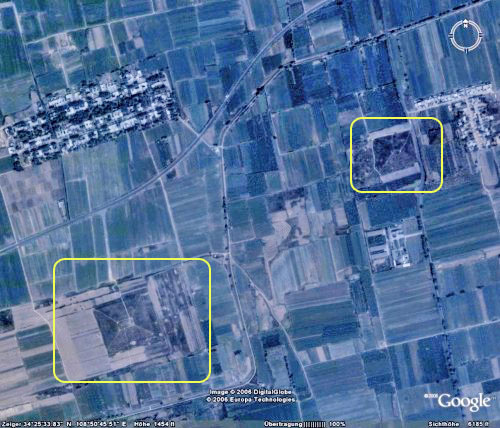
Two pyramids under the coordinates 34.26 North and 108.52 East.
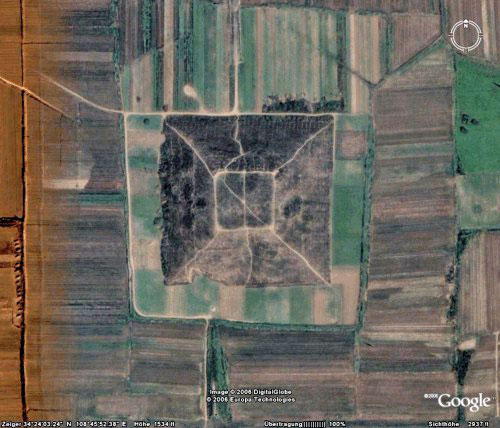
A further pyramid on 34.24 North and 108.45 East.
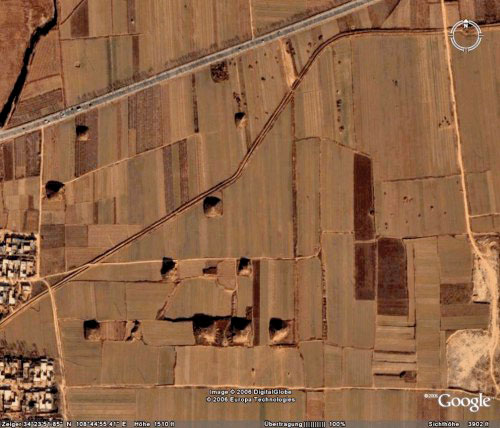
A field smaller pyramids near the city Xian.
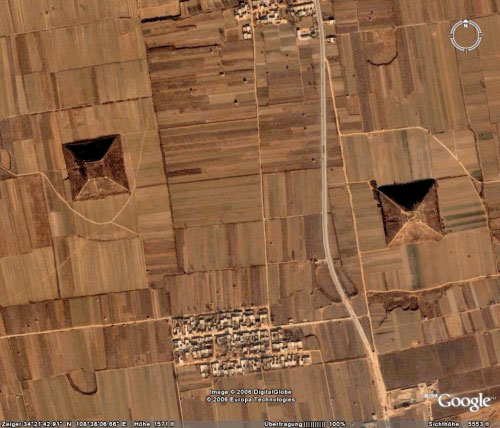
Two further pyramids in that area of the province Shaanxi.
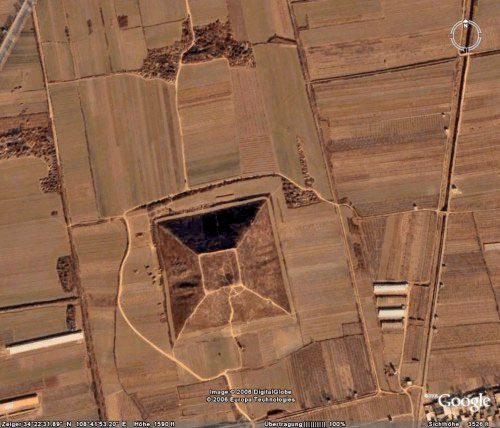
The probable "white pyramid" near the City Xian, on 34.22 North and 108.41 East.
It is definitely NOT the "white pyramid".
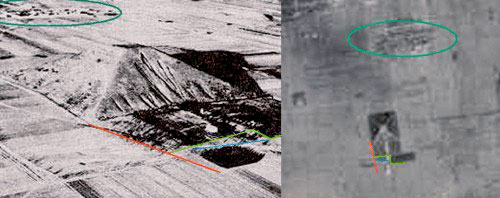
A comparison of a former satellite image of a pyramid in Shaanxi
with the photo of 1947 found in the homepage of earthquest.co.uk of November 2001.
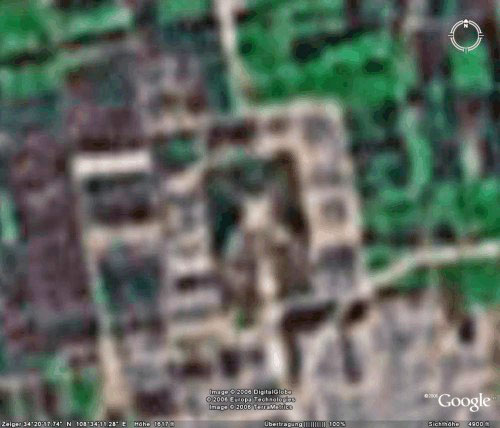
This pyramid. found by Google Earth in September 2006 is the well-known Maoling Mausoleum.
The comparison above shows that is the "white pyramid".
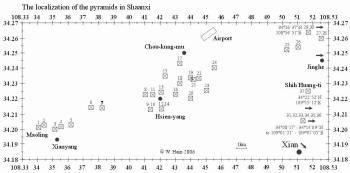
Pyramids map.
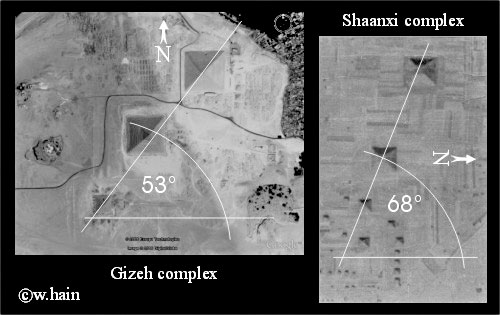
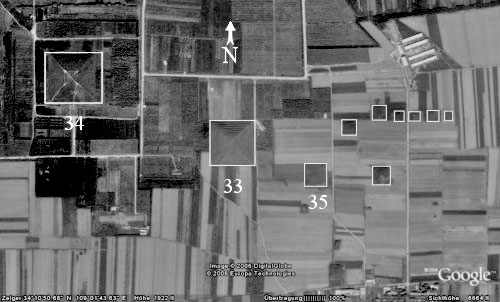
A comparison of the Gizeh pyramid complex with a pyramid complex in Shaanxi.
Since many years already in the popular scientific community and in publications there are many announcements and contentions of gigantic pyramids in China. The puzzle around the look-up seems final after new discoveries. With the help of Google Earth, the objects are to be seen impressively. It can not be maintained longer, there might be no pyramids in China.!
They have four sides and they are even square like the pyramids in Egypt and in Mexico. Its size can quite be matched with those of the Pharaohs and of the Mexican rulers.
Already in 1912 of the two travel agents Fred Meyer Schroder and Oscar Maman reported of a tremendous building that they had seen in China.
"It was more eerie than if we had found them in the wilderness. Here they had been under the nose of the world, but unknown to the western countries... The big pyramid is about 1,000 feet high (other descriptions estimate 1,000 to 1,200 feet high) and roughly 1,500 feet at the base, which makes it twice as large as any pyramid in Egypt. The four faces of the structure are oriented with the compass points," the two travellers reported.
During the second world war, the pilot of the American Air Force, James Gaussman, with his co-pilot, flow - through a technical defect at his machine -, for several times over a specific territory in China. What he later reported sounds completely unbelievable:
"I banked to avoid a mountain and we came out over a level valley. Directly below was a gigantic white pyramid. It looked like something out of a fairy tale. It was encased in shimmering white. This could have been metal, or some sort of stone. It was pure white on all sides. The remarkable thing was the capstone, a huge piece of jewel-like material that could have been crystal. There was no way we could have landed, although we wanted to. We were struck by the immensity of the thing", the pilots reported.
On March 28, 1947 the "New York Times" reported about that discovery. In an interview with the newspaper, the former far east director of the Transworld Airlines, Maurice Sheahan, says he has seen 40 miles southwest of Xian a gigantic pyramid.
"I was impressed by its perfect pyramidal form and its great size," says Sheahan.
Later, on March 30, 1947 the "New York Sunday Times" take over the report and published at the first the photo, which is actually made in 1945 by Gaussman, and that was soon forgotten.
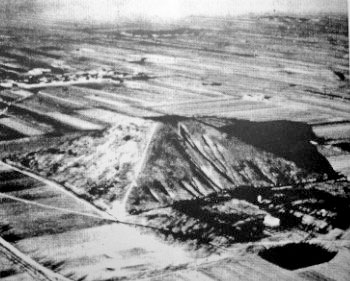
The photo of the "white pyramid" of 1945
In 1978 the New Zealand researcher Bruce L. Cathie bothered itself of a clarification of the puzzle. According to some correspondence with the Chinese embassy and the US air force he kept up the photo of 1947. He published the picture later in the first edition of his book "The Bridge to Infinity" of 1983. According to the photograph and the reports, the New Zealand researcher estimate that the pyramid must have at their basis a length of 450 meters (1500 feet) and a height of about 300 meters (1000 feet). It is a pyramid with four flat trapezoid shaped sides, a square plateau on the top and a square base, like the pyramids in Egypt and in Mexico.
Such pyramids were up to now unknown to the experts in the western world and its existence was always denied:
"There are no pyramids in China! Only pagodas - temple liked, peaked buildings", so the opinion of the world experts.
I came to the "white pyramid" when I already read reports in specialized books before and then I saw the appropriate photograph in the book "The Face on Mars" of 1989 from the two Australian authors Brian Crowley and James J. Hurtak. Brian Crowley then sent a copy of the image in his book to me and then I passed it to Peter Krassa - a Austrian book author and China researcher. Later I published it in my German book "Das Marsgesicht" (The Face on Mars) of 1995.
I have left indeed Peter Krassa the photograph, but I wanted to however make and therefore prove attentive, that there are in fact pyramids in China. At the German edition "Ancient Skies", the journal of the "Ancient Astronaut Society", no. 6, 1991, I published a short report. One did not want to however publish the photograph of 1947. Gene Phillips, the founder of the mentioned society, has refused a report from me in the American journal of the Society - with the reason, the photograph could be "something doctored", somehow falsified. He considered the photograph for a forgery.
However, I was some extent amazed when I saw a German book in a bookshop in Hamburg, Germany - during a lecture trip - with the title "Die weisse Pyramide" (The white pyramid), written by Hartwig Hausdorf, he was until then completely unknown to me. The book appeared in 1994 and then I found out that Peter Krassa had made the photograph available to him - without my knowledge. However, Hartwig Hausdorf mentioned me in his book so the case is functional. Hartwig Hausdorf was very much strove anyway - and that was also my aim - for the thing and he has undertaken several China trips, around the report to go onto the basis. He found several pyramid mountains in China in fact and he has also published photographs from that. These were the first real evidence that there are pyramidal buildings in China exist. The "white pyramid" could constitute Hausdorf nonetheless not.
Bruce L. Cathie announces many details in its book "The bridge to Infinity" over pyramids in China and especially over the "white pyramid" - so too precise coordinate information. They should be had found north of the contemporary city Sian (Xi´an), by the foot of the river Wei-ho - exact at 34.26 degrees of northern width and 108.52 degrees of eastern length. This data were for me very helpful when I searched in September 2006, with "Google Earth" over China after the pyramids. This program was in the last years set up extended from Google into the Internet and one can recognize fantastic details of the Earth's surface, by means of satellite consumption - as e.g. too the mysterious lines in the plain of Nazca. The solution is not in all fields optimally, nevertheless mostly quite well.
According to some trouble I then kept up after the coordinate information of Bruce L. Cathie two pyramids. As result, I found further, more than twenty and bigger pyramids. They are square earth-pillars, constructed by Chinese craftsmen a long time ago very obviously. The professional world has therefore improper. There are indeed pyramids in China! Google Earth confirmed that again. The biggest one in this area is on 34.23 degrees North and 108.42 degrees East. The opinions diverge via the age of the pyramids. Some speak of 2500 to 3500 years. The legendary "Emperor of the prehistoric time" should at that time have been there.
The pyramids are in the province Shaanxi, north of the city Sian (Xi´an). On the satellite photographs of Google Earth, no "white pyramid" is to be recognized. Under the coordinates 34.26 degrees of North and 108.52 degrees East, two pyramids are visible, but however they are not identical to the photo from 1947. The pyramid lying a little southwest, in my opinion, comes onto 34.22 North most of all and 108.41 East, north of the small city Hsien-yang into consideration. An arrangement shows similar factors as on the photograph from 1947: A square plateau, grazes (excavations) on the sidewalls, similar ones walkways (streets) and in the background, a small settlement. But that pyramid is definitely not the "white pyramid".
In some Internet pages (Chris Maier) and in the homepage of wikipedia, the Maoling mausoleum is compared with the "white pyramid". And that is in actual fact correct. Already on former satellite images which were published in the homepage of earthquest.co.uk of November 2001, that is to be recognized. With Google Earth, this pyramid - although at present another with bad resolution - is it to be seen also. They lies west of the pyramids of Hsien-yang, close to the city Xianyang, on 30.20 degrees North and 108.34 degrees East.
The "white pyramid" needs not to be a tremendous mystic building. The pilots and the travel agents to see the Maoling mausoleum, with his size - according to the measurements via Google Earth - of about 222 to 217 meters on the ground and his height of about 46 meters, can quite have appeared below glistening sunlight glimmering and quite big. No other pyramid in this area is so big. Only the one on 34.23 North and 108.42 East, which has a size of 219 to 230 meters on the ground.
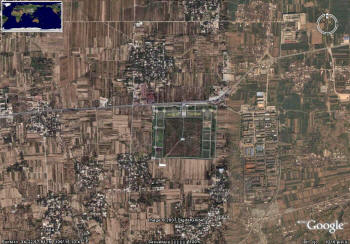 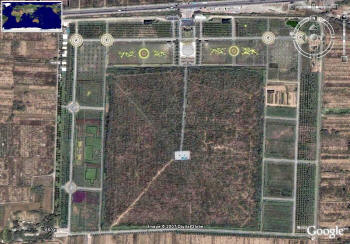
Emperor Qin Shihuang's Mausoleum
The well-known Shi Huang-ti Mausoleum, situated 50 kilometers East, has a size of 357 to 354 meters on the base and the whole complex has a size of 488 to 581 meters. But that grave mountain is actually a square mound and not a pyramid. Attainable is the area near Hsien-yang over the city Xi´an (Sian) obvious the airport that Hartwig Hausdorf with some traveling companions already used in 1994. They could for instance constitute seventeen pyramids within a radius of about three kilometers and they estimated its heights at sixty to seventy meters.
Some coordinates
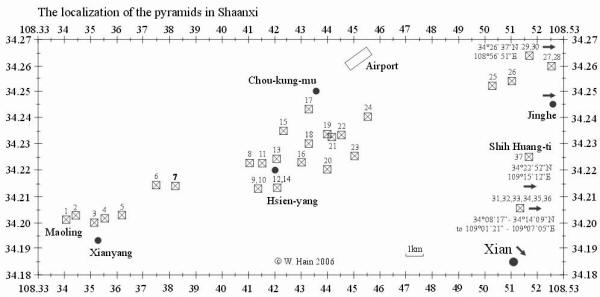
-
Maoling Mausoleum 1: size 222 x 217 m, 34°20'17"N 108°34'11"E
-
Pyramid 6: size 153 x 158 m, 34°21'47.16"N 108°37'49.80"E
-
Pyramid 7: size 149 x 155 m, 34°21'42.48"N 108°38'24.36"E
-
Pyramid 11: size 155 x 154 m, 34°22'29.64"N 108°41'51.36"E
-
Pyramid 15: size 219 x 230 m, 34°23'52"N 108°42'43"E
-
Pyramid 31: size 126 x 149 m, 34°14'09.00"N 109°07'05.00"E
-
Pyramids 33,34,35: biggest 160 x 167 m, 34°10'45.00"N 109°01'41.00"E
-
Huang-ti Mausoleum 37: size 354 x 357 m, 34°22'52"N 109°15'12"E
-
http://www.bibliotecapleyades.net/piramides/esp_piramides_china_5.htm
|
|
|
|
|
|
|
|
www.bibliotecapleyades.net/piramides/esp_piramides_china_3.htm
from CyberSpaceOrbit Website. Since the end of the Second World War, rumors
regarding the existence of giant pyramids in China have been appearing with ...
www.thelivingmoon.com/42stargate/03files/China_Pyramid.html
The pyramids of China are approximately 100 ancient mounds, many of ... of the
city of Xi'an, on the Qin Chuan Plains in the Shaanxi Province, central China.
www.world-mysteries.com/mpl_pyramidsofchina.htm
The Chinese govt have long denied the existence of 100 or so pyramids though
the increasing tourism to the Xian tombs area (the Terracotta Army) is ...
www.philipcoppens.com/china_pyr.html
But recent pictorial evidence proves that China's pyramids are indeed real, .... A
US Air Force map detailing the area around the city of Xian, made with the use of
...
www.unexplainedearth.com/xian.php
8 Dec 2004 ... Deep within China near the ancient capitol of Xi'an lies a series of pyramid
mounds virtually unknown outside the country. Entwined with the ...
world-pyramids.com/en/world-pyramids/asian.../chinese-pyramids/
YaSen Garden - a park located 15 km from the centre of Xi'an is the largest valley
of pyramids in Shaanxi province more than any in China. There are sixteen ...
|
|
|
|
www.youtube.com/watch?v=toNE14SKBLQ3 Abr. 2012 - 4 min. - Subido por SolGuildOfAstronomy
pyramids in China in Shinaaxi, discovered in 1912 by 2 travel agents, they reported large and ... |
www.earthquest.co.uk/china/china.html
29 Nov 2000 ... ... world - with NEW! Details on the Chinese pyramids. ... Most of them are located
in a 70-mile area around the city of Xi'an. This has mostly ...
googlesightseeing.com/2007/08/the-great-white-pyramid-of-china/
20 Aug 2007 ... Legend tells us that near the city of Xi'an, China, there lies a gigantic white
pyramid – far larger than any Egypti.
-
Anunciowww.mayoristadechina.com.ar/
Descubre los Mejores Programas y Precios para Viajar desde Argentina
|
|
|
|
|
|
|
Chinese pyramids
From Wikipedia, the free encyclopedia
Chinese pyramids are ancient mausoleums and burial mounds built to house the remains of several early emperors of China and their imperial relatives. About 38 of them are located around 25 kilometres (16 mi) - 35 kilometres (22 mi) north-west of Xi'an, on the Qin Chuan Plains in Shaanxi Province. The most famous is the Mausoleum of the First Qin Emperor, northeast of Xi'an and 1.7 km west of where the Terracotta Warriors were found[citation needed]. Chinese pyramids were also built during the Han, Tang, Song, and Western Xia dynasties.[citation needed]
They have flat tops, and thus are more similar in shape to the Teotihuacan pyramids north-east of Mexico City, Mexico than to the pyramids in Giza, Egypt. Although known in the West for at least a century, their existence has been made controversial by sensationalist publicity and the problems of Chinese archaeology in early 20th century.
Recognition in the West [edit]

Pottery figurines of domesticated animals and female servants dressed in silk robes, excavated from the mausoleum of Emperor Jing of Han ( r. 156-141 BC) near modern Xi'an (ancient Chang'an)
The introduction of pyramids in China to popular attention came in two stages. Many early stories were focused on the existence of "Great White Pyramid." U.S. Army Air Corps pilot James Gaussman is said to have seen a white jewel-topped pyramid during a flight between India and China during World War II. Colonel Maurice Sheahan, Far Eastern director of Trans World Airlines, told an eyewitness account of his encounter with a pyramid in the March 28, 1947 edition of The New York Times. A photo of Sheahan's pyramid appeared in The New York Sunday News on March 30, 1947. This photograph later became attributed to James Gaussman. Chris Maier showed that the pyramid in the photo is the Maoling Mausoleum of Emperor Wu of Han, just outside of Xi'an. Pseudohistorians, through promoting their theories, have increased western awareness of these pyramids. Hartwig Hausdorf speculated it was built by aliens, and Philip Coppens repeated this theory.
Despite claims to the contrary, the existence of these pyramid-shaped tomb mounds was known by scientists in the West before the publicity caused by the story in 1947. Shortly after the New York Times story, Science News Letter (now Science News) published a short item saying "The Chinese pyramids of that region are built of mud and dirt and are more like mounds than the pyramids of Egypt, and the region is little travelled. American scientists who have been in the area suggest that the height of 1,000 feet (300 m), more than twice as high as any of the Egyptian pyramids, may have been exaggerated, because most of the Chinese mounds of that area are built relatively low. The location, reported 40 miles (64 km) southwest of Sian, is in an area of great archaeological importance, but few of the pyramids have ever been explored." [2] Victor Segalen visited China in 1913 and wrote about the First Emperor's tomb (and other mound tombs in the region) in Mission Archeologique en Chine (1914): L'art funeraire a l'epoque des Han.[3]
Some of the pyramids of Xi'an are now tourist attractions and several pyramids have small museums attached to them.[citation needed]
Partial list of pyramids in China [edit]

Xi'an, area of the majority of pyramids in China.

A modern model portraying how Emperor Jing's tomb complex would have appeared upon completion
Zhou dynasty tombs complex near Luoyang, Henan [edit]
Zhao Kings' tombs complex near Handan, Hebei [edit]
Qin dynasty mausoleums near Xi'an, Shaanxi [edit]
Western Han dynasty mausoleums complex in Xianyang and around Xi'an, Shaanxi [edit]
Maoling Mausoleum group:
Pingling Mausoleum group:
Yanling Mausoleum group:
Kangling Mausoleum group:
Weiling Mausoleum group:
Group of two "tombs of Zhou Kings" (possibly from Han era):
- Tomb of King Wu of Zhou
- Tomb of King Wen of Zhou
http://en.wikipedia.org/wiki/Chinese_pyramids
|
|
|
 Primer
Primer
 Anterior
2 a 8 de 23
Siguiente
Anterior
2 a 8 de 23
Siguiente Último
Último
|
|
| |
|
|
©2024 - Gabitos - Todos los derechos reservados | |
|
|

